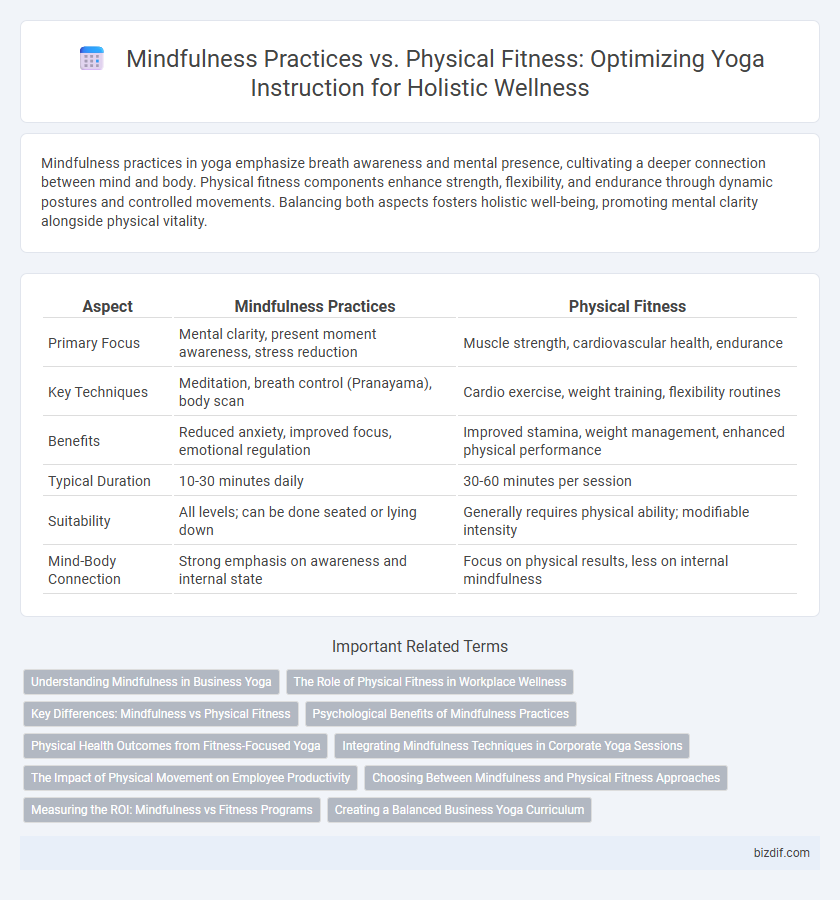Mindfulness practices in yoga emphasize breath awareness and mental presence, cultivating a deeper connection between mind and body. Physical fitness components enhance strength, flexibility, and endurance through dynamic postures and controlled movements. Balancing both aspects fosters holistic well-being, promoting mental clarity alongside physical vitality.
Table of Comparison
| Aspect | Mindfulness Practices | Physical Fitness |
|---|---|---|
| Primary Focus | Mental clarity, present moment awareness, stress reduction | Muscle strength, cardiovascular health, endurance |
| Key Techniques | Meditation, breath control (Pranayama), body scan | Cardio exercise, weight training, flexibility routines |
| Benefits | Reduced anxiety, improved focus, emotional regulation | Improved stamina, weight management, enhanced physical performance |
| Typical Duration | 10-30 minutes daily | 30-60 minutes per session |
| Suitability | All levels; can be done seated or lying down | Generally requires physical ability; modifiable intensity |
| Mind-Body Connection | Strong emphasis on awareness and internal state | Focus on physical results, less on internal mindfulness |
Understanding Mindfulness in Business Yoga
Mindfulness practices in business yoga emphasize mental clarity and stress reduction, fostering enhanced focus and emotional resilience among professionals. Unlike traditional physical fitness routines that prioritize bodily strength and endurance, mindfulness cultivates present-moment awareness and cognitive flexibility essential for effective decision-making. Integrating these practices within corporate wellness programs boosts employee productivity and supports sustained workplace well-being.
The Role of Physical Fitness in Workplace Wellness
Physical fitness plays a crucial role in workplace wellness by enhancing employees' energy levels, reducing stress, and improving overall productivity. Integrating yoga-based physical exercises fosters cardiovascular health, muscular strength, and flexibility, which contribute to reduced absenteeism and lower healthcare costs. Cultivating regular physical fitness habits alongside mindfulness practices creates a balanced approach to mental clarity and physical resilience in corporate environments.
Key Differences: Mindfulness vs Physical Fitness
Mindfulness practices concentrate on enhancing awareness, mental clarity, and emotional regulation through meditation, breathing exercises, and focused attention. Physical fitness emphasizes improving strength, endurance, flexibility, and cardiovascular health through physical activities like aerobic exercises, strength training, and stretching. The key difference lies in mindfulness targeting mental and emotional well-being, whereas physical fitness prioritizes bodily health and physical performance.
Psychological Benefits of Mindfulness Practices
Mindfulness practices in yoga promote psychological benefits such as stress reduction, enhanced emotional regulation, and improved mental clarity, which physical fitness alone may not fully achieve. Techniques like focused breathing and meditation foster increased present-moment awareness, supporting anxiety management and resilience. These mental health improvements complement physical fitness by cultivating a balanced mind-body connection essential for holistic well-being.
Physical Health Outcomes from Fitness-Focused Yoga
Fitness-focused yoga enhances physical health outcomes by improving muscle strength, flexibility, and cardiovascular endurance. Studies show consistent practice reduces blood pressure, supports weight management, and boosts metabolic function. This approach targets body conditioning, complementing traditional mindfulness techniques for a balanced wellness routine.
Integrating Mindfulness Techniques in Corporate Yoga Sessions
Integrating mindfulness techniques into corporate yoga sessions enhances employee well-being by reducing stress and improving focus, complementing physical fitness benefits such as increased flexibility and strength. Mindfulness practices like breath awareness and body scans foster mental clarity and emotional regulation, essential for high-pressure work environments. This holistic approach promotes sustained productivity, workplace harmony, and overall health among staff.
The Impact of Physical Movement on Employee Productivity
Incorporating mindful physical movement, such as yoga stretches, into the workday enhances employee productivity by reducing stress and boosting mental clarity. Scientific studies show that regular physical activity increases oxygen flow to the brain, improving concentration and cognitive function. Employers who integrate yoga-based mindfulness practices observe higher engagement levels and decreased absenteeism.
Choosing Between Mindfulness and Physical Fitness Approaches
Choosing between mindfulness practices and physical fitness approaches depends on individual goals such as stress reduction, emotional balance, or cardiovascular health. Mindfulness techniques like meditation and breath awareness enhance mental clarity and emotional resilience, while physical fitness activities, including strength training and aerobic exercise, improve muscle tone and overall endurance. Integrating both can create a holistic yoga regimen that supports body-mind harmony and long-term wellness.
Measuring the ROI: Mindfulness vs Fitness Programs
Measuring the ROI of mindfulness practices versus physical fitness programs involves assessing improvements in mental clarity, stress reduction, and emotional resilience alongside physical health metrics such as strength, flexibility, and cardiovascular endurance. Mindfulness practices demonstrate significant ROI through enhanced cognitive function, reduced healthcare costs from stress-related illnesses, and improved workplace productivity. Physical fitness programs provide quantifiable benefits in body composition, disease prevention, and overall physical performance, making a balanced integration of both approaches optimal for holistic well-being.
Creating a Balanced Business Yoga Curriculum
Creating a balanced business yoga curriculum integrates mindfulness practices with physical fitness to enhance overall well-being and productivity. Emphasizing breath awareness, meditation, and gentle movement supports stress reduction and mental clarity, while strength-building asanas and cardiovascular exercises improve physical health and stamina. Combining these elements fosters a holistic approach that caters to diverse client needs and promotes sustainable wellness in corporate environments.
Mindfulness Practices vs Physical Fitness Infographic

 bizdif.com
bizdif.com